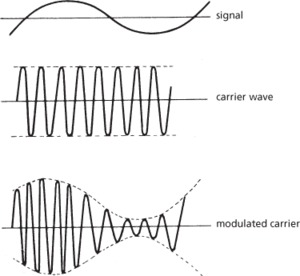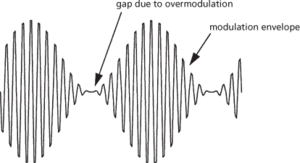See modulation; radio.
See modulation.
The process whereby a signal is sent over a transmission line by changing the amplitude of a wave known as a carrier.
A type of modulation in which the amplitude of the carrier wave is varied above and below its unmodulated value by an amount proportional to the amplitude of the signal wave and at the frequency of the modulating signal (Fig. a).

(a) Amplitude modulation
If the modulating signal is sinusoidal then the instantaneous amplitude e, of the amplitude-modulated wave may be given as
where A is the unmodulated carrier amplitude and B the peak amplitude variation of the composite wave, p is equal to 2π × modulating signal frequency and ω to 2π × carrier frequency. If the modulation factor or index, m, is defined by m = B/A then the modulated wave may be given as
The modulation factor is sometimes quoted as a percentage of the carrier signal amplitude and is then termed the percentage modulation.
If the peak amplitude of the composite wave equals the peak amplitude of the unmodulated carrier, the instantaneous amplitude of the composite wave will equal zero at its minimum. The ratio of B to A is then unity and the percentage modulation is 100%. If the amplitude of the modulating signal, B, is further increased, a condition known as overmodulation results and a ‘gap’ in the signal occurs (Fig. b). This gap produces a type of distortion called sideband splatter and can result in the transmission of frequencies that are outside the normal allocated frequency range for the transmission. This type of distortion can cause severe interference to other adjacent stations.

(b) Overmodulation in amplitude modulation
A variation on conventional amplitude modulation results from the recognition that the amplitude-modulated signal consists of a carrier and two sidebands, one above the carrier and the other below. The actual information is contained in the sidebands and, if the carrier and one sideband is eliminated before transmission, the resulting form of transmission is called single-sideband or SSB. The carrier alone can also be suppressed, resulting in suppressed carrier modulation.
If the modulating signal is not sinusoidal but is made up of discrete levels, the resulting modulation is known as amplitude shift keying (ASK). Any number of discrete amplitude signal levels can be used. If only two levels are used, one of which is zero, the result is binary amplitude shift keying; this is also known as on-off keying. An alternative form of binary amplitude modulation is two-tone modulation, in which the carrier is always transmitted. Instead of the carrier simply being turned on or off, the carrier is amplitude modulated by two different sinusoidal signals representing either a one, or a mark, and a zero, or a space. The two frequencies are commonly separated by 170 hertz. Two-tone modulation is commonly used in telegraphy systems.
A composite modulation called quadrature amplitude modulation (QAM) results if the carrier wave is simultaneously amplitude- and phase-modulated (see phase modulation). If the modulating signal always has the same amplitude, but can have any of four phases, the resulting modulation is called quadrature phase shift keying (QPSK). The advantage of QPSK is that it reduces out-of-band interference. Out-of-band performance can be improved further by reducing the change in phase at each transition. Such schemes are called minimum shift keying (MSK).
Amplitude modulation may be achieved using a radiofrequency class C amplifier or oscillator. The carrier wave is produced in the amplifier or oscillator. The modulating signal is superimposed on it by varying either anode voltage (anode modulation) or the grid bias (grid modulation) in proportion to the modulating signal if a valve is being used in the transmitter. Alternatively the modulating signal is superimposed on the carrier by varying the base or collector voltages in proportion to the modulating signal if a bipolar transistor is being used in the transmitter. In either case the output of the circuit is then an amplitude-modulated radiofrequency wave.
Compare frequency modulation.
- detonating gas
- detonation
- detoxification
- detrending
- detrital
- detrital remanent magnetization
- detritivore
- detritus
- detritus feeder
- detrusor muscle
- Dettingen, Battle of (27 June 1743)
- detune
- DEUCE
- deus ex machina
- deus sive natura
- deuteranopia
- deuterated compound
- deuteric alteration
- deuteric reaction
- deuterium
- deuterium oxide
- Deuteromycota
- deuteron
- deuterostome
- deutoplasm